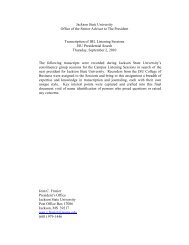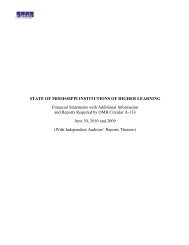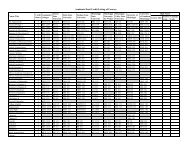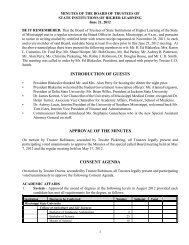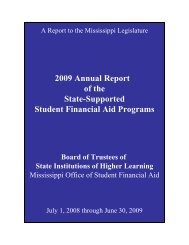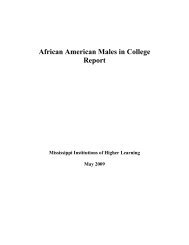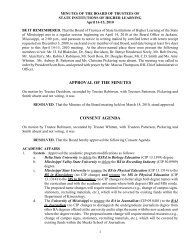Motor Vehicle And Fleet Management Best Practice Guidelines
Motor Vehicle And Fleet Management Best Practice Guidelines
Motor Vehicle And Fleet Management Best Practice Guidelines
Create successful ePaper yourself
Turn your PDF publications into a flip-book with our unique Google optimized e-Paper software.
miles or two hours is also a recommendation of the National SafetyCouncil.5. Time of day should be limited.National Safety Council discourages driving between the hours of midnightand 6:00 a.m. due to the condition of other drivers and the likelihood offatigue and/or meeting other drivers who are intoxicated.6. Drivers should be held responsible for the safe and lawful operation of thevehicle they are driving.Auto insurance and the MS Tort Claims Act will apply to liabilities whileoperating in the course and scope of one’s duties. Deviations from dutyand violations of state or federal law should be understood. For thesereasons and others, allowing non-employees to drive university-ownedvehicles is discouraged. Authorization for non-employees to driveuniversity-owned/rented/leased vans should be documented.7. Vans should carry no more than 10 people.This includes the driver and up to nine passengers. This recommendationis based on NHTSA recommendations. With just ten passengers, the vanwill still be operating at triple the risk of roll-over than if the van wereempty. With eight people, the risk is 2.2X. Limiting the total number toeight is also a common practice. Removal of one or more rear seats willhelp facilitate this practice.8. Vans should be loaded from front to rear.Fill front seats first to avoid under-steerage problems. All things beingequal, place heaviest part of load (passengers or equipment) toward thefront.9. Roof racks or other “car-top carriers” should be prohibited.The risk of roll-over is magnified with the height of cargo.10. Cargo should be low and secure.Keeping the center of gravity low will help reduce the risk of roll-over. Tiedownstraps, cargo cages, or other restraints should be used to preventcargo from shifting during transit or from causing additional injury in theevent of a collision.11. All occupants must wear safety-belts (lap and shoulder).Driver should make sure everyone is properly secured prior to operation ofvehicle. The number of properly working seat-belts should determine themaximum number of passengers.12. Towing (if allowed) should not be done with passengers.If it is absolutely necessary to tow a trailer with such a van, no more thanone passenger (to assist driver) should be onboard the van. Other cargowithin vehicle specifications can be allowed. Owner’s manual should be<strong>Motor</strong> <strong>Vehicle</strong> and <strong>Fleet</strong> <strong>Management</strong> <strong>Best</strong> <strong>Practice</strong> <strong>Guidelines</strong> 25



